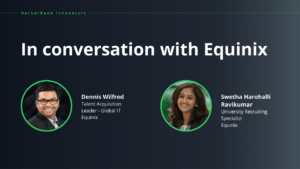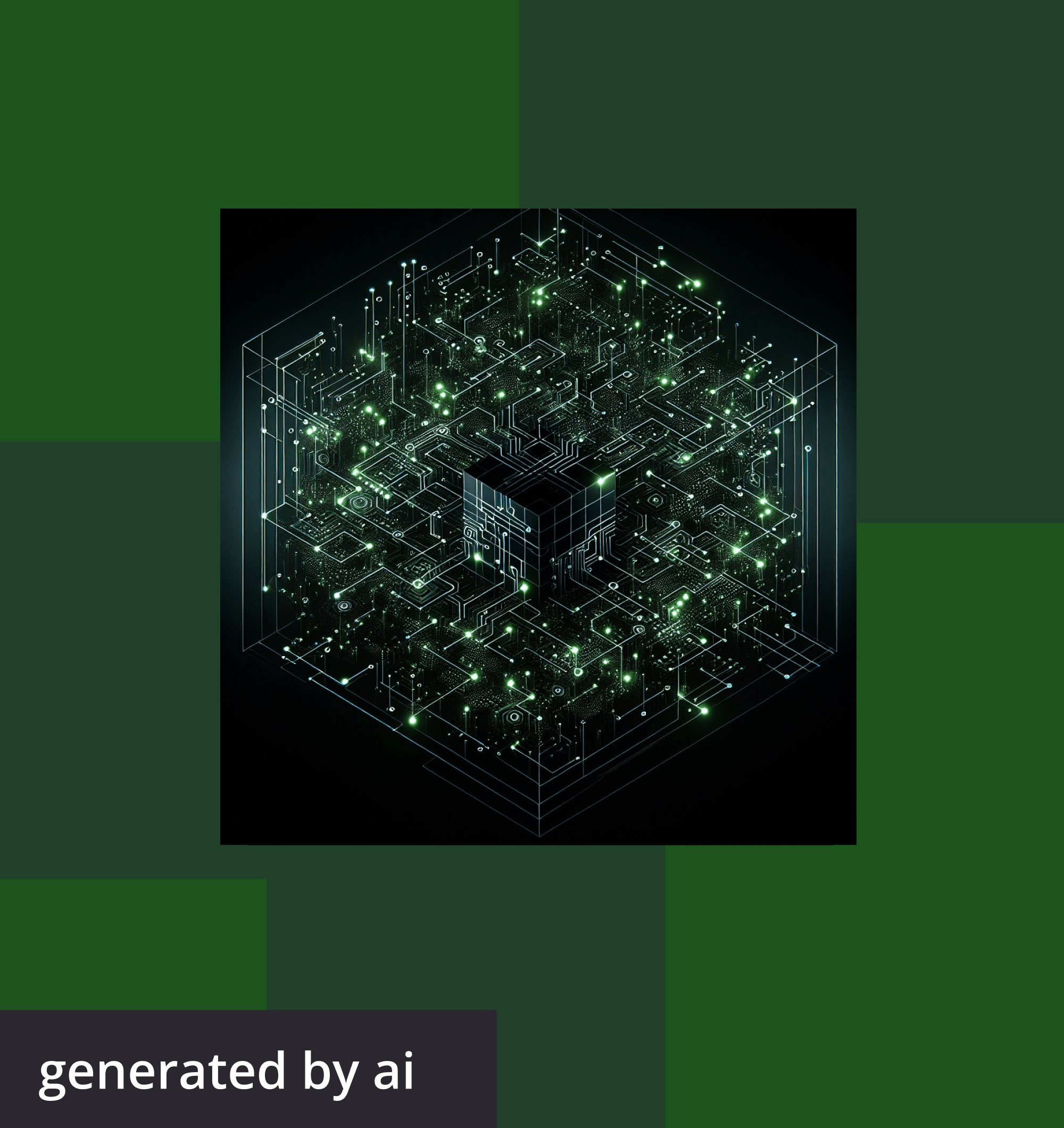
Equinix is the world’s digital infrastructure company®. Digital leaders around the world leverage Equinix’s reliable platform to seamlessly integrate and connect core infrastructure at the pace of software. In addition to building innovative solutions that help organizations scale with agility and deliver world-class experiences, Equinix also continues to make progress on its sustainability goals. Founded in 1998 in Silicon Valley, Equinix has grown exponentially in the last few decades and has more than 250 data centers around the world.
So, in order to understand the scale, challenges, and tech stack involved in hiring at such a scope, we had a conversation with Swetha Harohalli Ravikumar, University Recruitment Specialist, and Dennis Wilfred, Talent Acquisition Lead – Global IT, at Equinix.
Their insights paint a comprehensive portrait of Equinix’s journey in India – in ensuring they not only create positive experiences for candidates and hiring managers, but also ensure the quality of candidates selected meet their global bar.

-
What were the primary challenges Equinix encountered in attracting and retaining talent before implementing HackerRank Engage? Can you provide some context on this?
Swetha Harohalli Ravikumar: When I first joined Equinix, the company was in its early stages of hiring interns and graduates in India. Through years of collaboration with universities, we had recently welcomed our most significant batch of interns and graduates.
I observed that since it was one of our initial forays into hiring this demographic, we needed external support to liaise with some of the universities. Given our rapid growth in India, especially with Bangalore emerging as a hub for Equinix in the IT space, it was important for us to establish stronger ties with academic institutions.
The challenge was that Equinix, being more of a B2B enterprise, was not well-known to the student demographic. This posed a hurdle when engaging with students, many of whom had set expectations when considering their placements. Our goal was more than just recruitment; we wanted to create an ongoing dialogue with these students, many of whom we hoped to bring on board for internships in the coming years.
Dennis Wilfred: Equinix’s foray into India began with the acquisition of a company. Following this acquisition, we decided to establish our global IT development center in Bangalore. Given this strategic move, our immediate priority was to seek out talent with diverse skills to help us build our IT organization in the region.
However, our entry into the Indian market came with its set of challenges. Notably, while some segments of the industry, like platform or data teams, were familiar with Equinix, many in the developer community weren’t. Considering our focus on the IT and developer side, building brand awareness became essential.
Further complicating matters was the fact that our hiring managers, given our acquisition-driven entry, were predominantly from regions like Singapore, the US, and Europe. Acclimating them to the nuances of the Indian job market, its talent landscape, cultural differences, and challenges such as candidates declining offers, required deliberate effort on our part.
Another specific challenge we grappled with was the considerable amount of time hiring managers were investing in initial candidate evaluations. More often than not, every candidate profile we received looked promising, leading to a high number of interviews. However, these extensive efforts weren’t translating into successful hires at the rate we anticipated. Recognizing this inefficiency, we saw the need for a platform or tool that would assist in evaluating candidates, allowing us to present only the top-tier profiles to our managers.
Moreover, we wanted to enrich the experience for both hiring managers and candidates. In the past, a manager might speak to dozens of potential hires, with only a fraction making it to the final stages. We envisioned a system where managers would engage deeply with a smaller, more curated pool of candidates, dedicating time to elaborate on the role, our tech stack, the problems we aim to solve, and the impact we strive to create. This change in approach not only improves the hiring process but also provides candidates with a clearer understanding of what Equinix aims to achieve in India.
It was at this juncture that we considered partnering with an organization that could address these challenges. Among the solutions we evaluated, HackerRank emerged as a compelling option. Our primary goal was to streamline the hiring process, ensuring quality interactions and delivering top-tier candidates to our hiring managers. With HackerRank, we were able to provide candidates with real-world coding challenges, offering them insights into the problems we’re tackling.
Today, I’m proud to say that our hiring process in India has matured. Almost every hiring requirement undergoes this refined assessment. We’ve even introduced this method in Poland and are piloting it with a few managers in the US and Singapore.
-
Could you provide insights into the types and numbers of roles Equinix is currently pursuing? Specifically, the job families and developer roles. Are you still actively recruiting for positions in software engineering, AI, ML, and cloud? A brief overview of your hiring objectives would be immensely helpful.
Dennis Wilfred: In 2022, we filled around 300 positions. This year, we’ve successfully closed around 80 positions in India and have another 30 to 40 on the docket before the year closes out. Our estimate is that we’ll conclude the year with about 120 to 150 new hires.
Our recruitment spans various job families and levels. We’ve ranged from hiring principal architects to software engineers, ensuring we have a diversified skill set on board. This year, we also initiated several Centers of Excellence (CoEs) in India. For instance, we introduced a platform CoE focused on predictive modeling and enterprise planning, among others like Oracle CPU and Siebel. Another critical addition was the Business Systems Analyst role under our enterprise planning and management segment, which plays a pivotal role within Equinix.
While our numbers might seem modest, our emphasis this year was truly on quality. HackerRank played an instrumental role in ensuring we identified top-tier talent. The establishment of these CoEs in India signifies the trust and confidence our business leaders now place in the Indian talent pool. We’re also proud to announce that we recently hired our principal architect for our ServiceNow domain under the WebCut organization, further solidifying our technical capabilities.
-
What were the main factors that led you to choose HackerRank over the other competitors you looked into?
Dennis Wilfred: One of the primary reasons we leaned towards HackerRank was its global reach. Your presence in multiple regions stood out.
Another compelling factor was the breadth and depth of the skill stack and the library of assessments you offer. We didn’t find such a comprehensive list with any other organization. Some catered mainly to early career individuals or newcomers to the field, while others, relatively new in the industry, simply lacked the types of assessments that you possess. The flexibility that HackerRank offers in creating assessments wasn’t matched by any other organization.
The CodePair feature was another strong selling point. We wanted to move away from mere multiple-choice questions to a more interactive and reflective assessment system. It’s not just about ticking boxes for us, and the same goes for candidates. They’re eager to understand and solve actual problems, which is evident in the challenges we present. This approach was influential in convincing our leaders and other regions, like Poland, to adopt this method. They were more inclined to see an issue that mirrored real-life scenarios rather than just theoretical questions.
Proctoring, too, was a key feature that we valued. In sum, all these factors combined made HackerRank the ideal choice for us.
Swetha Harohalli Ravikumar: Though I wasn’t part of the initial conversations, since I wasn’t with Equinix when we initiated the partnership with HackerRank, my engagement with the platform made it evident why it was chosen. It was an obvious choice, given the exemplary features and adaptability that Dennis elaborated on. The checks and safeguards embedded in HackerRank are commendable.
It’s not just about ticking boxes; it’s about HackerRank’s proactive approach in addressing emerging challenges. This is especially vital when considering the vast audience of new and early-career individuals. These students are sharp, always exploring ways to get an edge or bypass the system. HackerRank’s continual technological innovation to preempt and address such integrity issues underscores its value to us.
-
Regarding your engagement, could you provide some qualitative results or specific success metrics that illustrate the benefits you’ve experienced with HackerRank? We’d also love to know why you believe it has been effective for you.
Swetha Harohalli Ravikumar: One primary benefit was the multitude of touchpoints we managed to establish with students. While we spearheaded the marketing efforts and outreach to universities, HackerRank insights about registration rates, email open rates, and click-throughs provided crucial data about our outreach effectiveness. It allowed us to discern which colleges were more active and which ones required renewed effort.
The touchpoints were instrumental. For example, out of 1,400 registrations, we witnessed participation from over 650 students. Traditionally, such a high conversion from registration to participation is rare, which indicates the effectiveness of our engagement strategy.
Moreover, post-challenge, the support from the HackerRank team was commendable. Their timely assistance, clarification of back-end processes, and overall support greatly impacted our evaluation process.
Quantitatively, the sheer volume of individuals we reached and engaged with was impressive. On a qualitative note, the evaluation metrics and subsequent discussions with engineers provided clarity about participants’ performances. This has helped us identify potential candidates for future internships, ensuring a pipeline of quality candidates. Both in terms of volume and quality, our experience with HackerRank was immensely positive and metrically sound.
Dennis Wilfred: The preliminary feedback has been overwhelmingly positive. We’ve even introduced it to our brand marketing team, expecting them to delve deeper and explore its full potential. Moving forward, our experiences and the feedback gathered have all been positive, and we’re eager to tap into it more intensively. In fact, one of our immediate plans is to initiate an internal hackathon, different from our usual external ones.
-
Beyond the candidate management features and visibility metrics you mentioned, were there additional benefits you noticed with “Engage”? Specifically, its impact on branding or initial impressions and experiences when Equinix began utilizing the platform.
Swetha Harohalli Ravikumar: Over the course of my career, I’ve worked with several vendors to orchestrate hackathons. My experience with Engage has been distinctly positive, distinguishing it from others I’ve used before. Its most commendable trait is the platform’s intuitiveness. Unlike other platforms where navigation might pose challenges, Engage is straightforward. After discussing with our marketing team, I found it simple to incorporate their inputs, which allowed us to mold and modify our setup to align perfectly with our vision.
The time to set things up was also a very positive surprise. Within a span of just a day or two, the entire setup was operational. The HackerRank team gave a number of constructive suggestions, which helped us further improve. It’s not just the setup phase that’s efficient; the entire user journey on Engage minimizes unnecessary complexities. With past vendors, I often found myself stuck in a constant loop of communications for even the most minor alterations. Engage, however, allowed us a degree of autonomy that reduced this back-and-forth, allowing us to effect changes without being overly reliant on external support.
The structure of the platform, from the initial registration to intermediate touchpoints and finally to the challenge, is very intuitive and easy to set up. This systematic approach helped us in establishing constant communication with candidates.
The depth and breadth of insights offered by HackerRank tests, from the granular details like time metrics to a broader overview of participants’ skill levels, are unparalleled. For any organization, ensuring a balance between quality and quantity is pivotal. While catering to large participant numbers is essential, it should never come at the cost of quality. Engage ensures we never have to make that compromise. The platform not only aids in reaching out to a vast audience but also ensures that the engagement is meaningful and the results are trustworthy.
Dennis Wilfred: A significant advantage for us was the reduced need for hands-on management. In my prior organizations, we spent countless hours assessing and sorting through candidates. Thankfully, with HackerRank, most of that heavy lifting was done for us.
Our main responsibility shifted towards branding and outreach. It gave me the opportunity to focus on key colleges, especially those we’ll likely return to for intern recruitment. This freed-up time allowed us to foster deeper relationships with the coordinators and better understand the kind of students we wanted to engage. It’s about cultivating an environment and rapport that will benefit us not just now, but in the long run. They now recognize Swetha, are familiar with Equinix, and this familiarity can be invaluable.
In the past, we often found ourselves bogged down by the technicalities of a platform. Concerns ranged from whether the system could handle the assessment load to ensuring the right candidates were being targeted, and troubleshooting any potential glitches. This time, thanks to HackerRank, the experience was seamless.
From a branding perspective, the convenience cannot be stated enough! I’m not sure about the exact time it took, but updating content on the platform was quick and straightforward. We didn’t need to call in our brand team or liaise with colleagues in Singapore. Essentially, the platform is user-friendly, allowing even someone new from our team to hop on, make necessary edits, and push content without hurdles.
-
Have you received any feedback from your candidates and hiring managers about their experience during the process?
Swetha Harohalli Ravikumar: Till now, the overall sentiment has been positive. And one positive sign, from my perspective, is that we received minimal queries during the challenge. In past experiences with similar events, I’ve often been completely bogged down with questions about registration, login issues, and procedural concerns by candidates. This time, there were barely any, except for a few on the challenge day from students who might’ve missed checking their emails. This lack of issues suggests that the platform was user-friendly and seamless for most participants, from registration to the challenge completion.
Dennis Wilfred: The feedback from candidates has also been encouraging. We prioritize getting perspectives from both selected and rejected candidates. One significant benefit of HackerRank is its transparency; candidates gain clear insights into the challenges we aim to address. They appreciate the consistency in our assessment approach, which contrasts with the varied questions they might encounter from different interview panelists.
In particular, the coding exercise – where candidates are given a task and later present their solution – has been transformative. It provides them with a tangible sense of the problems we tackle. I was initially skeptical about its reception, especially among data science candidates who often prefer direct discussions with team leaders. However, the feedback has been outstanding, making the entire HackerRank experience extremely positive for us.
-
How’s the quality and fit of candidates improved since you started using HackerRank Engage?
At first, introducing HackerRank faced some resistance. It was a new initiative and represented a shift in our hiring approach. However, once the hiring managers began to observe the high-quality candidates flowing through the pipeline post-assessment, their perspective shifted. The caliber of these candidates was precisely what they were looking for.
We initially piloted HackerRank with a few managers. After witnessing its success, we shared these success stories with other leaders, and it is now widely adopted across departments. Now, my team conducts regular check-ins every quarter with the hiring managers who have used HackerRank to ensure it consistently meets our standards. The feedback, so far, has been overwhelmingly positive.
We’ve actively sought areas of improvement and have received constructive feedback from managers across various sectors, from data science to full-stack engineering. The positive results in India also affected its implementation in Poland and a pilot in the US. One manager, who had experienced HackerRank’s benefits in India and was later hiring in the US, advocated for its use there, and is now leading its adoption in Singapore too.
What stood out for us was the idea of continuous engagement. It wasn’t about a single touchpoint; it was about creating a sustained presence. Through various platforms, like dedicated web pages and consistent email communications, we ensured that Equinix remained top of mind for these students over extended periods.
Our internal talent marketing team has been instrumental in these outreach efforts, amplifying our presence and intent. Given our substantial footprint in the IT sector, especially with a significant number of engineers based in Bangalore, most of our roles naturally cater to this skill set.
We also made a conscious move towards hosting a diversity hackathon. One of our overarching objectives is to foster a more diverse team at Equinix, especially in our Bangalore branch. These were some of the driving factors behind our initiatives.

